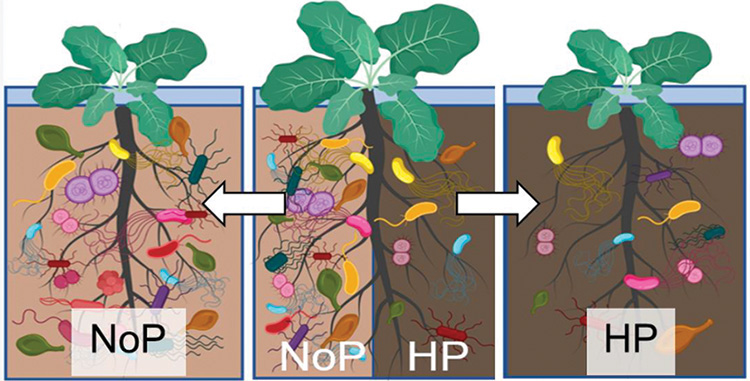The root microbiome changes based on nutrient need
KEY RESULT:
As researchers added phosphorus to the soil, microorganism diversity in the canola root microbiome went down. The roots didn’t need to “recruit” as many microorganisms.
PROJECT NAME, PRINCIPAL INVESTIGATOR:
“Understanding canola root morphology and microbiomes in response to soil phosphorus fertility” Bobbi Helgason and associate Alex (Mengying) Liu, University of Saskatchewan; Leon Kochian, Global Institute for Food Security; David Schneider, U of S; Isobel Parkin, Agriculture and Agri-Food Canada Saskatoon
FUNDING:
SaskOilSeeds, Global Institute for Food Security
Canola plant roots assemble or recruit a community of microorganisms to help with nutrient uptake, and that community – the root-associated microbiome – changes depending on what the plant needs.
This study looked at the root-associated microbiome in soils with low and high levels of phosphorus (P). Researchers ran field studies at the Agriculture and Agri-Food Canada research farm at Scott, Saskatchewan and at the Conservation Learning Centre at Prince Albert, Saskatchewan. They also ran growth room experiments using Scott soil as a medium. Canola growing in narrow clear “rhizoboxes” allowed them to observe root growth patterns in the soil. Background levels of soil available P were considered minimally sufficient (with around 25 ppm of P).
Results:
In general, as researchers added P to canola growing in controlled-condition rhizoboxes, microorganism diversity in the microbiome went down. Because sufficient P is there, plant roots perhaps don’t recruit as much variety in the bacteria and fungi they associate with.
Interestingly, rhizobox studies showed that early canola growth was higher in plants where half of the root system was exposed to fertilized soil and the other half to unfertilized soil. Each half of the root system had a distinct root microbiome indicating that the root-microbiome system may confer the best advantage in soil where P availability is variable – as would be found in most field soils. This also supports the common practice of putting starter P in the seed row to give the crop an early jump and then letting lateral roots gather P from the soil.

Credit: Alex (Mengying) Liu
Researchers also observed that the abundance of fungal pathogens that cause blackleg and sclerotinia were correlated with the no-P application. The no-P application appeared to make plants more susceptible to these pathogens, although disease symptoms were not assessed.
Overall, the plant microbiome response to P was inconsistent in the field, reflecting the complex factors contributing to soil P availability and canola uptake. Higher baseline levels of P may have been a factor. Expected associations may not occur when P is not the most limiting factor in plant growth and the root-associated microbiome.
Humic acid study inconclusive
Key result:
This one-year study, conducted in 2023, observed no noticeable plant density and yield improvements by treating mono-ammonium phosphate (MAP) fertilizer with humic acid. Humic acid is an organic substance formed during plant decomposition. It is often promoted as a nutrient enhancer, but Saskatchewan has limited research. Unfortunately, drought and heat stress affected all trial locations in this one-year study. Researchers also note that the bulked nature of tissue samples impedes the ability to draw precise conclusions. They recommend further research with a more targeted approach.
Study name, principal investigator:
“Response of canola and flax to humic-acid-coated phosphorus fertilizer (MAP) rates” Gursahib Singh, Irrigation Crop Diversification Corporation; Robin Lokken, Conservation Learning Centre; Chris Holzapfel, Indian Head Agricultural Research Foundation; Mike Hall, East Central Research Foundation
Funding:
SaskOilseeds




